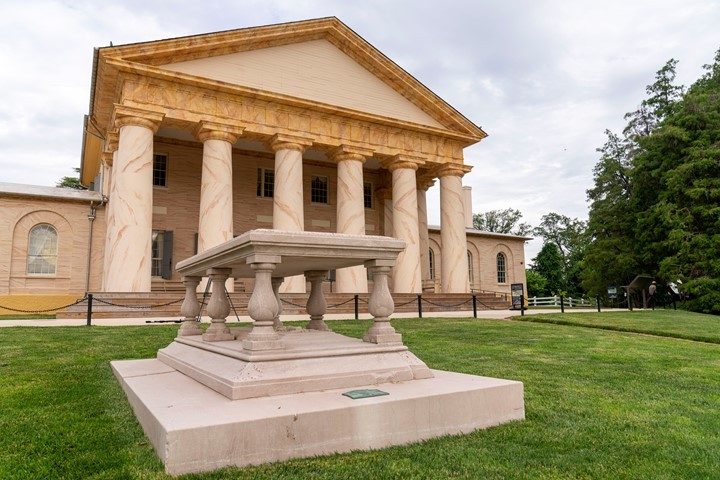
Podcast: Play in new window | Download ()
Subscribe: Android | RSS | More
The reopening of Robert E. Lee’s home — Arlington House — on Tuesday was used as an occasion for ABC News to offer up a one-sided smear of the man who led the Army of Northern Virginia during the Civil War.
Located on the grounds of Arlington National Cemetery, Lee’s estate was essentially confiscated by the United States at the end of the war and used as a burial ground. The mansion, which Lee inherited from his father-in-law, George Washington Parke Custis — the adopted son of George Washington — was built by Custis in honor of Washington, the nation’s first president and commander-in-chief of the Continental Army. Lee married Custis’s daughter, Mary Anna Randolph Custis, and when Custis died, they inherited the estate.
The mansion was reopened to the public by the National Park Service following a $12 million rehabilitation. The reopening would have happened earlier, but various delays, chiefly the COVID-19 shutdowns, extended its closure.
Amid the reopening celebrations, Lee’s historical reputation is being trashed, with an “increased emphasis on those who were enslaved there,” according to ABC News, a reference to Custis’s slaves who lived there, and were subsequently freed by Lee. Philanthropist David Rubinstein financed the rehabilitation.
The new emphasis on the slaves who lived there — until Lee freed them — is handicapped by the truth that little was written about them, according to Charles Cuvelier, the superintendent of the George Washington Memorial Parkway, the unit of the National Park Service that manages Arlington House. But new exhibits were unveiled at the mansion, which nevertheless included the enslaved Syphax and Norris families.
ABC News, in its report on the reopening, opted to smear the reputation of Lee, largely by leaving out certain important facts about Lee and his governance of the estate in the 1850s, prior to the Civil War. For example, ABC said, “The Norris family included Wesley Norris, who according to some accounts escaped from Arlington House in 1859 when Lee was managing the estate. When Norris was captured, Lee insisted that Norris be whipped 50 times and that the wounds be washed with brine, according to newspaper accounts, including one given by Norris directly to an anti-slavery newspaper.” (Emphasis added).
Note that ABC offered no evidence that contradicted the propaganda of an anti-slavery newspaper, which could be expected to slander the good name of Lee. The truth is that Lee had denounced slavery long before the war began. In a letter to his wife from Camp Brown in Texas, written on December 27, 1856, Lee described his feelings about slavery. “I believe,” Lee wrote, “in this enlightened age, there are few who will not acknowledge that slavery as an institution is a moral and political evil.”
Of course, ABC neglected to cite those words of Lee’s, and it is doubtful if the National Park Service will use those words in their tours of the mansion. So, why did Lee own slaves? As the late Paul Harvey used to say, here is the “rest of the story.” Lee, a career military officer, owned no slaves until he and his wife inherited Arlington from her father, an estate which included slaves. The Custis will made it practically impossible for Lee to free them immediately. As Douglas Southall Freeman wrote in his Pulitzer Prize–winning R.E. Lee, the will contained a provision that only when Custis’s debts were all paid, were the slaves to be emancipated.
“The immediate trouble,” Freeman wrote, “was that Mr. Custis left more than $10,000 of debt and virtually no money with which to operate the estate.” Lee dug into his own modest financial resources to save the estate. He could have simply sold the slaves to pay off the debts — which would have left them in slavery to someone else, but Lee did not want to do that to them. Within a few years, he was able to emancipate the slaves — before Abraham Lincoln’s “Emancipation Proclamation.”
Freeman also disputes the ugly charge that Lee had his slaves beaten. “There is no evidence, direct or indirect, that Lee ever had them or any other Negroes flogged … This was Lee’s first experience with the extravagance of antislavery agitators. The libel, which was to be reprinted many times in later years with new embellishments, made him unhappy,” Freeman wrote.
Notice that ABC News made no effort to work in Freeman’s words into their story, either.
Now, Steve Hammond, a descendant of Syphax family, even wants to remove Lee’s name from Arlington House. According to ABC News, Hammond is “optimistic that Arlington House can now serve to engender broader conversations about the lives of all who resided there.”
Part of that “broader conversation” should include these truths that ABC News decided to leave out.

